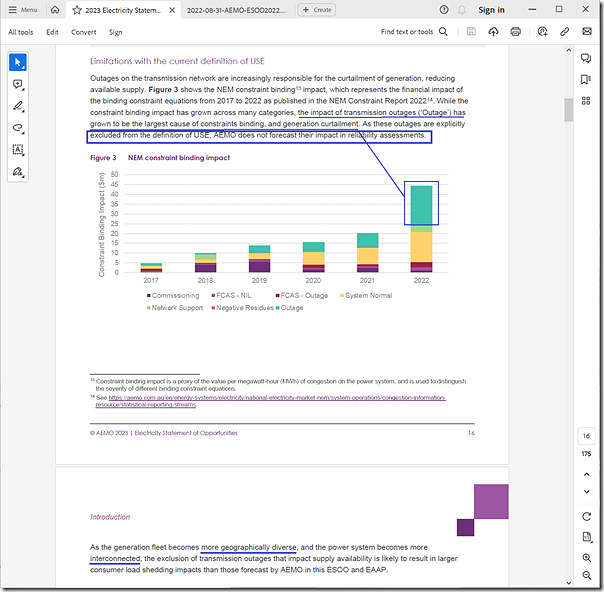Note that I have this out as a separate, short article for several purposes – including that it will be more directly referenceable in future.
It’s meant to tie in with today’s broader review of the 2023 ESOO here (which is still being completed).
—-
Also to AEMO’s credit, in section 1.1 of the 2023 ESOO they help to clarify both:
1) that the model behind the ESOO excludes limitations beyond ‘System Normal’ …
2) and illustrates (via Figure 3) that these types of ‘Outage’ constraints (which are excluded from the modelling) are becoming increasingly material to market outcomes …
(a) Figure 3 shows the commercial effect (in terms of $Millions of impact); but
(b) Also worth remembering that these types of outages can have reliability impacts as well.
Here’s p16/175 of the ESOO with some bits highlighted to help readers understand:
On 11th May 2023 on this site, Ryan Esplin from Endgame wrote ‘How dispatch works … it’s much more than just a bid stack’ in order to illustrate the significant impact that NEMDE constraints have on dispatch outcomes.
1) Some of these constraints are ‘System Normal’ (i.e. always invoked, representing the fully intact system); but
2) There are almost always other ‘Outage’ related constraints in play … and these (as the AEMO illustrates above) can be quite meaningful.
There is only a single reference to ‘system normal’ across all 175 pages (at least in terms of what Acrobat search came up with), and that’s on p61/175 in section 4.1 here:
‘In addition to the reliability risks described above, numerous factors excluded from ESOO modelling may further impact consumer outcomes in operational timeframes. These include:
• The risk of abnormal transmission system conditions – the ESOO applies a ‘system normal’ forecast to transmission availability, where the transmission system in each region is presumed to be available and in full working order. Likely and regular occurrence of security and reliability incidents on the regional transmission systems can have a prolonged impact on the ability for generation to be transmitted to meet customer needs.
• … .’ [continues with other factors not relevant to this particular article]
Whilst it’s great that the AEMO has gone to some lengths to highlight this exclusion in the modelling (though I did not see any journalists pick this up in my review earlier), in my view that’s (at best) a consolation prize for readers of the 2023 ESOO who are particularly interested in the ‘will the lights stay on?’ question.



Leave a comment